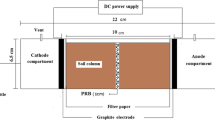Abstract
The process of electrokinetic remediation (EKR) of clay soil containing an admixture of a typical organic pollutant, ethylbenzene, which is often found in it near gas stations and oil product storage facilities, is studied. Experimental measurement of the dependence of the concentration of this pollutant on time and the spatial coordinate during electrokinetic soil decontamination is carried out on a specially designed installation using the chromato-mass spectrometric method and a procedure close to that described in the guidelines of the MUK 4.1.1061-01. In order to intensify the EKR process of organic pollutant, the method of using an aqueous solution of two surfactants as the process fluid—anionite AB-17 and neonol AF 9-12—is applied. The experimental results are processed using the empirical-mathematical method described in the previous article and the function proposed in it. A good approximation of the experimental concentration dependences on both coordinates is demonstrated using this function: in all the experiments considered, the coefficients of determination R2 > 0.9986. The parameters of the approximating functions are calculated. The curves of the boundaries of the achievement of the concentration of ethylbenzene in soil samples of the level of the maximum permissible concentration (MPC) ≤ 0.5 mg/kg in the EKR process are determined. Based on these data, practical recommendations are proposed for choosing the conditions and modes of conducting the EKR process, which minimize the time and financial costs and improve its quality.







Similar content being viewed by others
REFERENCES
I. V. Kumpanenko, A. V. Roshchin, N. A. Ivanova, A. V. Bloshenko, I. P. Tikhonov, and A. M. Skryl’nikov, Russ. J. Phys. Chem. B 11, 543 (2017). https://doi.org/10.1134/S199079311704008X
I. V. Kumpanenko, N. A. Ivanova, N. Yu. Kovaleva, N. A. Sakharova, O. V. Shapovalova, and A. V. Roshchin, Russ. J. Phys. Chem. B 16, 738 (2022).
I. V. Kumpanenko, N. A. Ivanova, O. V. Shapovalova, et al., Russ. J. Phys. Chem. B 16 (5) (2022, in press).
Y. B. Acar and A. N. Alshawabkeh, Environ. Sci. Technol. 27, 2638 (1993). https://doi.org/10.1021/es00049a002
Y. B. Acar, R. J. Galeb, A. N. Alshawabkeh, et al., J. Hazard. Mater. 40, 117 (1995). https://doi.org/10.1016/0304-3894(94)00066-P
A. T. Yeung, Sep. Purif. Technol. 79, 124 (2011). https://doi.org/10.1016/j.seppur.2011.01.022
D. L. Wise, D. J. Trantolo, E. J. Cichon, et al., Remediation Engineering of Contaminated Soils, Environmental Science and Pollution (CRC, New York, 2000).
W. Liu, J. Differ. Equat. 246, 428 (2009). https://doi.org/10.1016/j.jde.2008.09.010
A. N. Alshawabkeh and Y. B. Acar, J. Geotech. Eng. 122, 186 (1996). https://doi.org/10.1061/(ASCE)0733-9410(1996)122:3(186)
Y. B. Acar, A. N. Alshawabkeh, and R. A. Parker, Report No. EPA/600/R-97/054 (U. S. Environ. Protect. Agency, Cincinnati, OH, 1997).
P. Tsai, C.-H. Huang, and E. Lee, Langmuir 27, 13481 (2011). https://doi.org/10.1021/la203240b
Yu. A. Leikin, I. V. Kumpanenko, A. V. Roshchin, et al., Ross. Khim. Zh. (Zh. Ros. Khim. Ob-va im. D. I. Mendeleeva) 57 (1), 52 (2013).
C. C. West, Environ. Sci. Technol. 26, 2324 (1992). https://doi.org/10.1021/es00036a002
J. W. Mercer and R. M. Cohen, J. Contam. Hydrol. 6, 107 (1990). https://doi.org/10.1016/0169-7722(90)90043-G
D. Lestana, C. Luob, and X. Lib, Environ. Pollut. 153, 3 (2008). https://doi.org/10.1016/j.envpol.2007.11.015
M. J. Rosen, J. Am. Oil Chem. Soc. 66, 1840 (1989). https://doi.org/10.1007/BF02660759
C. Yuan and C.-H. Weng, Chemosphere 57, 225 (2004). https://doi.org/10.1016/j.chemosphere.2004.05.02
MUK (Guidelines) 4.1.1061-01 (2001).
A. P. Perez and N. R. Eugenio, JRC Tech. Rep. EC (2018), p. 1. doi
I. V. Kumpanenko, N. A. Ivanova, N. Yu. Kovaleva, N. A. Sakharova, K. A. Shiyanova, and A. V. Roshchin, Russ. J. Phys. Chem. B 15, 131 (2021).
Funding
This study was carried out as part of a state assignment for Semenov Federal Research Center for Chemical Physics of the Russian Academy of Sciences on the topic 1.1., no. 122040500058-1.
Author information
Authors and Affiliations
Corresponding author
Rights and permissions
About this article
Cite this article
Kumpanenko, I.V., Shiyanova, K.A., Panin, E.O. et al. Spatiotemporal Profiles of Ethylbenzene Concentrations in Clay Soil During Its Electrokinetic Remediation. Russ. J. Phys. Chem. B 16, 1164–1171 (2022). https://doi.org/10.1134/S1990793122060185
Received:
Revised:
Accepted:
Published:
Issue Date:
DOI: https://doi.org/10.1134/S1990793122060185




